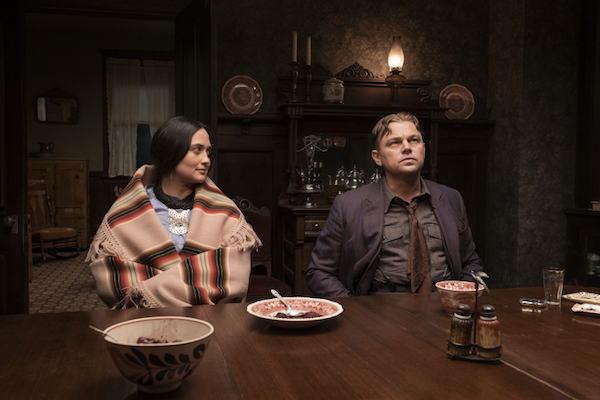Movie review by Greg Carlson
Doing press for “Killers of the Flower Moon,” Martin Scorsese has defended the movie’s three and a half hour running time (presented during its theatrical engagement with no intermission), but the results on the screen do the real talking. The master director’s latest American original – a sturdy blend of genres and conventions including the Western, the “based on a true story” lesson and history-by-suggestion, the family epic, the melodrama, and the crime/gangster film – come together to make something unique to the special artistry of Scorsese, who is most certainly one of our finest living motion picture directors.
David Grann’s nonfiction book of the same title pulls together many threads to explicate an underrepresented chapter of our country’s racist past. The seemingly worthless land inhabited by the members of the Osage Nation covered oil reserves that enriched the tribe beyond anyone’s wildest dream of wealth. As a result, a crooked scaffold of laws, regulations, schemes, plots, and plans were erected by white people to siphon as much money as possible into their own pockets. Attitudes of entitlement, superiority, and unchecked avarice led to an epidemic of murdered Osage in the early 1920s.
The brilliance of Scorsese’s adaptation revolves around two interpersonal relationships: the romantic bond and marriage between Leonardo DiCaprio’s Ernest Burkhart and Lily Gladstone’s Mollie Kyle and the sinister alliance between Burkhart and his uncle William Hale (Robert De Niro). DiCaprio fashions a career-best performance as the utterly fucked-up Burkhart. The man’s restlessness and greed are at first the only signifiers of Ernest’s personal drive and motivation. The actor’s instincts to lobby for the part of Burkhart instead of taking the role of federal investigator Tom White (in early drafts, the story was told from the lawman’s perspective) prove correct.
Gladstone is mesmerizing in the most difficult and challenging of the central roles. For much of the movie, Mollie is an invalid deliberately mistreated with spiked insulin administered by Ernest. Film critics and Gladstone’s collaborators have sung the praises of her contributions to the film. And there is no doubt that she deserves all accolades, but I would have appreciated an opportunity to spend time with Mollie in equal measure to the minutes devoted to Ernest. In his “New Yorker” review, Richard Brody lays out a convincing case for Mollie’s use of silence and Scorsese’s reasons for minimal character psychology. It may just be part of the larger point that Ernest does things while Mollie has things done to her.
The glue that holds the huge and sweeping “Killers of the Flower Moon” together is the strange and inexplicable love between Ernest and Mollie, even as Ernest’s moral bankruptcy is a constant reminder of the unwholesome, unholy, and degrading treatment of Native Americans by men like Hale, whose evil is as terrifying as anything seen in a horror movie. Because this particular rendition was not directed by a member of the Osage Nation, it cannot be what Chris Eyre would call an “inside job.” As such, Gladstone’s interpretation of Mollie becomes even more important as the means by which viewers of all races come to appreciate and understand Scorsese’s point of entry to this vital moment in time.
